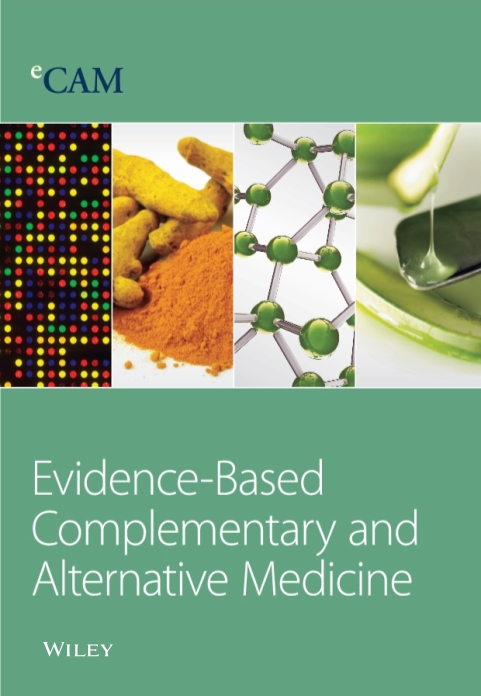Antidepressant-Like Activity and Molecular Docking Analysis of a Sesquiterpene Lactone Isolated from the Root Bark of Ximenia americana (L.)
4区 医学
Q2 Medicine
Evidence-based Complementary and Alternative Medicine
Pub Date : 2024-02-03
DOI:10.1155/2024/6680821
引用次数: 0
Abstract
Depression, a global cause of disability and premature death, is often treated by traditional healers in Africa using medicinal herbs such as Ximenia americana (L.). With recent pharmacological studies showing the potential antidepressant properties of X. americana extract, this study aimed to evaluate the antidepressant-like effects of the compound(s) isolated from X. americana extract using the forced swim test (FST) and tail suspension test (TST) models predictive of depression. The extracts, administered orally within a dose range of 100–400 mg/kg, notably decreased the immobility time in both the FST and the TST. The most significant reduction occurred at the highest dose of 400 mg/kg, with a decrease of 117.66 s in FST and 53.5 s in TST. However, this reduction in immobility was not linked to changes in movements, as observed in an open-field test (OFT), suggesting that the effect of the extracts was not due to activation of locomotion. Subsequently, a sesquiterpene lactone, dehydrocostus lactone (1) was isolated through solubility-based fractionation and column chromatography of the active root bark extract of X. americana. Dehydrocostus lactone (400 mg/kg) demonstrated a 46.50 s reduction in immobility time in the FST, which was comparable to the positive control, imipramine (30 mg/kg). With a highly favorable docking score of −8.365 kcal/mol on an antidepressant target, monoamine oxidase A (MAO-A; pdb ID: 2BXS), dehydrocostus lactone (1) potentially outperforms the standard MAO-A inhibitor drug, isocarboxazid (−5.847 kcal/mol). Dehydrocostus lactone (1) displayed strong interactions involving hydrogen bond and hydrophobic and electrostatic interactions with specific MAO-A binding site residues. These findings highlight that the antidepressant-like activity of X. americana is partly attributed to the presence of dehydrocostus lactone. Additionally, it also supports the traditional medicinal use of the plant for treating depression.从 Ximenia americana(L. )根皮中分离出的一种倍半萜内酯的抗抑郁活性和分子对接分析
抑郁症是导致残疾和过早死亡的一个全球性原因,非洲的传统治疗师经常使用 Ximenia americana(L.)等药草治疗抑郁症。最近的药理学研究表明,X. americana 提取物具有潜在的抗抑郁特性,因此本研究旨在利用预测抑郁症的强迫游泳试验(FST)和尾悬试验(TST)模型,评估从 X. americana 提取物中分离出来的化合物的抗抑郁作用。在 100-400 毫克/千克的剂量范围内口服这些提取物可显著缩短强迫游泳试验和尾悬浮试验中的静止时间。最高剂量为 400 毫克/千克时,减少幅度最大,FST 减少了 117.66 秒,TST 减少了 53.5 秒。然而,正如在开阔地试验(OFT)中所观察到的那样,不动性的降低与运动的变化无关,这表明提取物的作用并不是由于激活了运动。随后,通过对 X. americana 的活性根皮提取物进行基于溶解度的分馏和柱层析,分离出一种倍半萜内酯--脱氢木内酯(1)。去氢木香烃内酯(400 毫克/千克)在 FST 中可减少 46.50 秒的不动时间,与阳性对照亚胺培南(30 毫克/千克)相当。脱氢木香内酯(1)在单胺氧化酶A(MAO-A;pdb ID:2BXS)这一抗抑郁靶点上的对接得分为-8.365 kcal/mol,非常有利,有可能超过标准的MAO-A抑制剂药物异恶唑(-5.847 kcal/mol)。去氢木香内酯(1)与特定的 MAO-A 结合位点残基之间存在强烈的相互作用,包括氢键、疏水作用和静电作用。这些发现突出表明,X. americana 的抗抑郁活性部分归因于脱氢木香内酯的存在。此外,这也支持了该植物治疗抑郁症的传统医学用途。
本文章由计算机程序翻译,如有差异,请以英文原文为准。
求助全文
约1分钟内获得全文
求助全文
来源期刊
自引率
0.00%
发文量
1983
审稿时长
2.2 months
期刊介绍:
Evidence-Based Complementary and Alternative Medicine (eCAM) is an international, peer-reviewed journal that seeks to understand the sources and to encourage rigorous research in this new, yet ancient world of complementary and alternative medicine.
The journal seeks to apply scientific rigor to the study of complementary and alternative medicine (CAM) modalities, particularly traditional Asian healing systems. eCAM emphasizes health outcome, while documenting biological mechanisms of action. The journal is devoted to the advancement of science in the field of basic research, clinical studies, methodology or scientific theory in diverse areas of Biomedical Sciences. The journal does not consider articles on homeopathy.

 求助内容:
求助内容: 应助结果提醒方式:
应助结果提醒方式:


